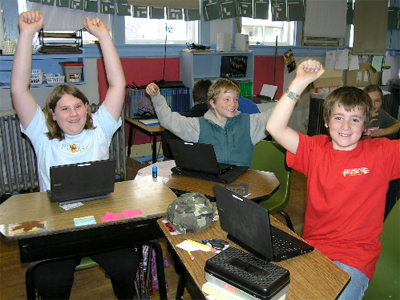 (Bridgewater Village, VT) With the Digital Wish training wrapping up, teachers at Bridgewater Village Elementary School reminisced on their experiences this past year. Mercy Grinold, the third and fourth grade teacher, was impressed by the students taking initiative, learning at a fast pace, and even teaching the teacher at times! She commented about the benefit of teachers learning along with the students in the classroom, so that as a classroom community everyone could rally together later to offer “aid in putting together a Prezi, using the Smartboard, or figuring out how to enlarge a screen to show a video.” This is a prime example of how students at this age can absorb information quickly, and even offer helpful advice and reminders to the parents, siblings, peers, and teachers in their lives. It is all one could hope for in a 1:1 computing program – students demonstrating their learning in a real-world situation.
(Bridgewater Village, VT) With the Digital Wish training wrapping up, teachers at Bridgewater Village Elementary School reminisced on their experiences this past year. Mercy Grinold, the third and fourth grade teacher, was impressed by the students taking initiative, learning at a fast pace, and even teaching the teacher at times! She commented about the benefit of teachers learning along with the students in the classroom, so that as a classroom community everyone could rally together later to offer “aid in putting together a Prezi, using the Smartboard, or figuring out how to enlarge a screen to show a video.” This is a prime example of how students at this age can absorb information quickly, and even offer helpful advice and reminders to the parents, siblings, peers, and teachers in their lives. It is all one could hope for in a 1:1 computing program – students demonstrating their learning in a real-world situation.
Mercy even touches on one particular example of a student helping out in a difficult situation. “During our school’s weekly morning meeting presentation, I was having ‘technical difficulties.’ The computer was not connecting to the projector properly, the screen display was incorrect, the sound muted. Who came to my rescue? Not the teachers but students! I heard my third grader whispering a directive from the audience, a fourth grader was trouble-shooting the slides, and a fifth grade student connected the projector and computer.” This type of student empowerment is essential in today’s world, where students can take charge of their own learning and feel validated for their technological knowledge and for what they can contribute to a classroom, school, or community.
Jeff Symanski, the fifth and sixth grade teacher at Bridgewater Village Elementary, took the e-Vermont / Digital Wish program one step further and challenged his students to create an online showcase for their work.
Jeff explains, “In November, I assigned the fifth and sixth graders Google accounts with various goals. The main goal was and continues to be for the students to create and update a personal website that would be a place for them to post completed work. Their website could serve as an “electronic” portfolio. There are many benefits and countless goals for this project. Technology standards as well as those in literacy are met through the ongoing process of creating, updating, and editing individual websites.”
The students are nearing completion of these electronic portfolios and look forward to sharing them with family and the community. It’s important to have all of these experiences as a young person, especially in a rural state like Vermont. In order to be competitive in the future job market, computer literacy is extremely important. Developing solid basics at a young age is the best way to go about learning technology so that students gain proficiency at adapting to the ever-changing computer hardware environment.
Jeff explains that this past year has been a huge leap for his students’ future successes in the Vermont workforce. “Educating children as early as elementary school in computer literacy makes sense. Technology is so integrated in our lives and it is important that our students keep up with all of the changes and advancements. Tied in all of the lessons was the message, ‘You learned all of these programs, now let’s think about putting this to use as a future adult Vermonter, contributing to your state.’” With programs like e-Vermont and Digital Wish training, the future of the Vermont workforce is looking bright.
